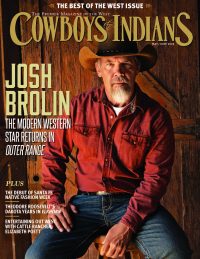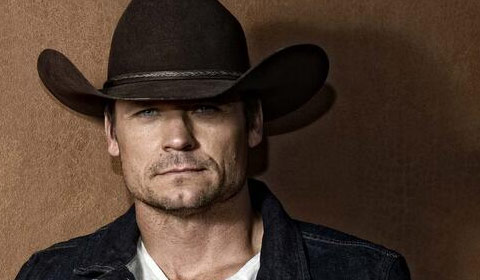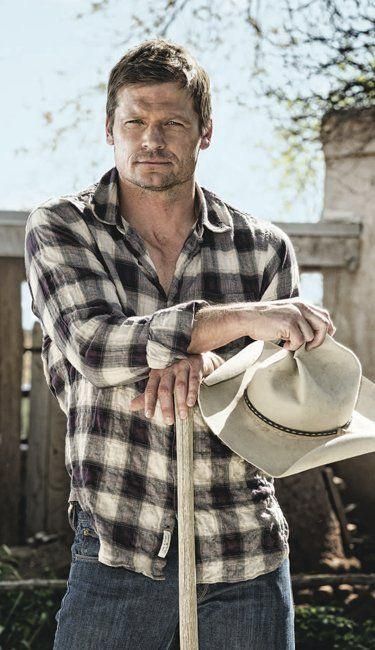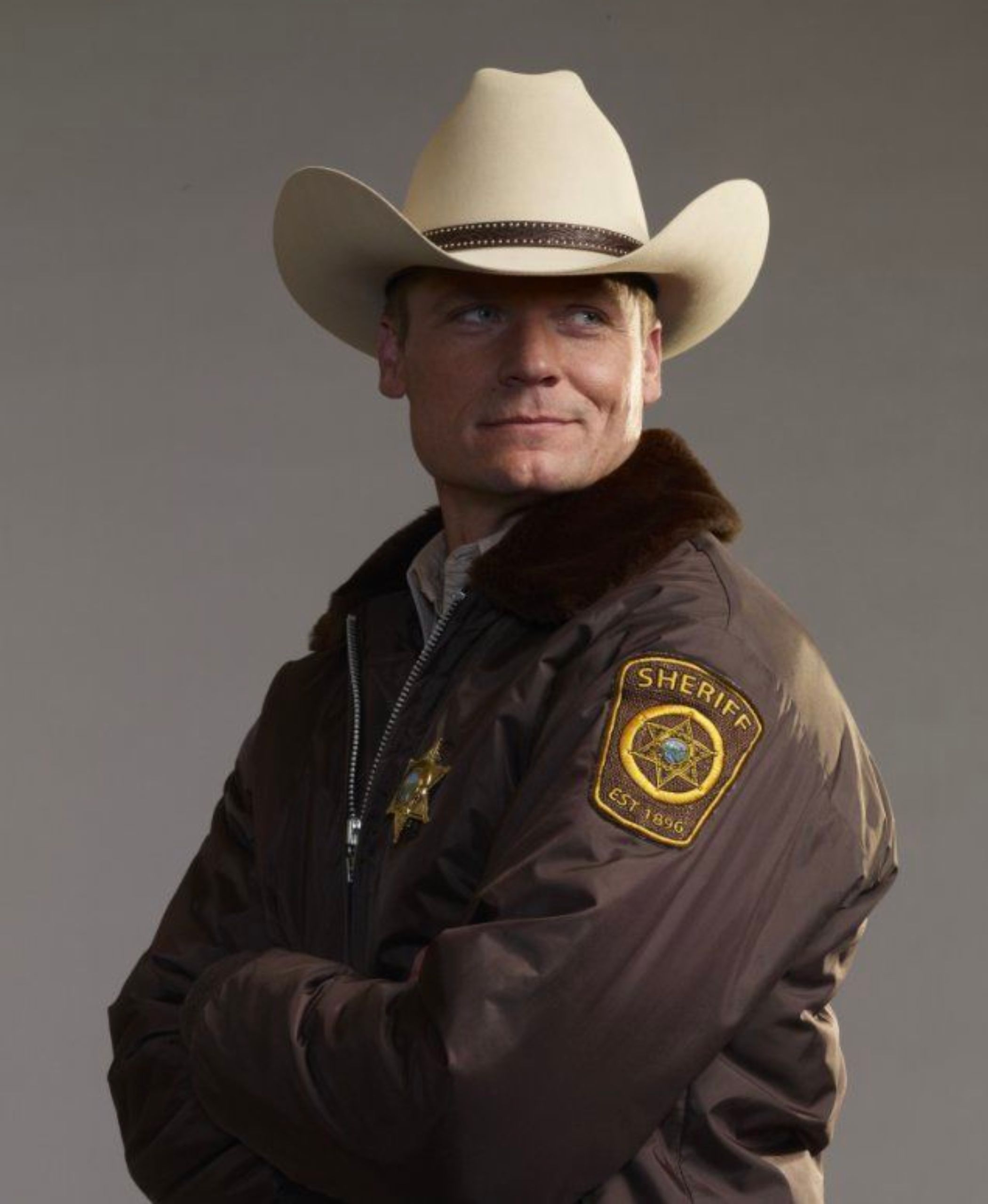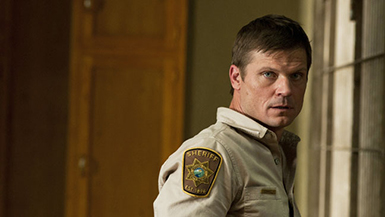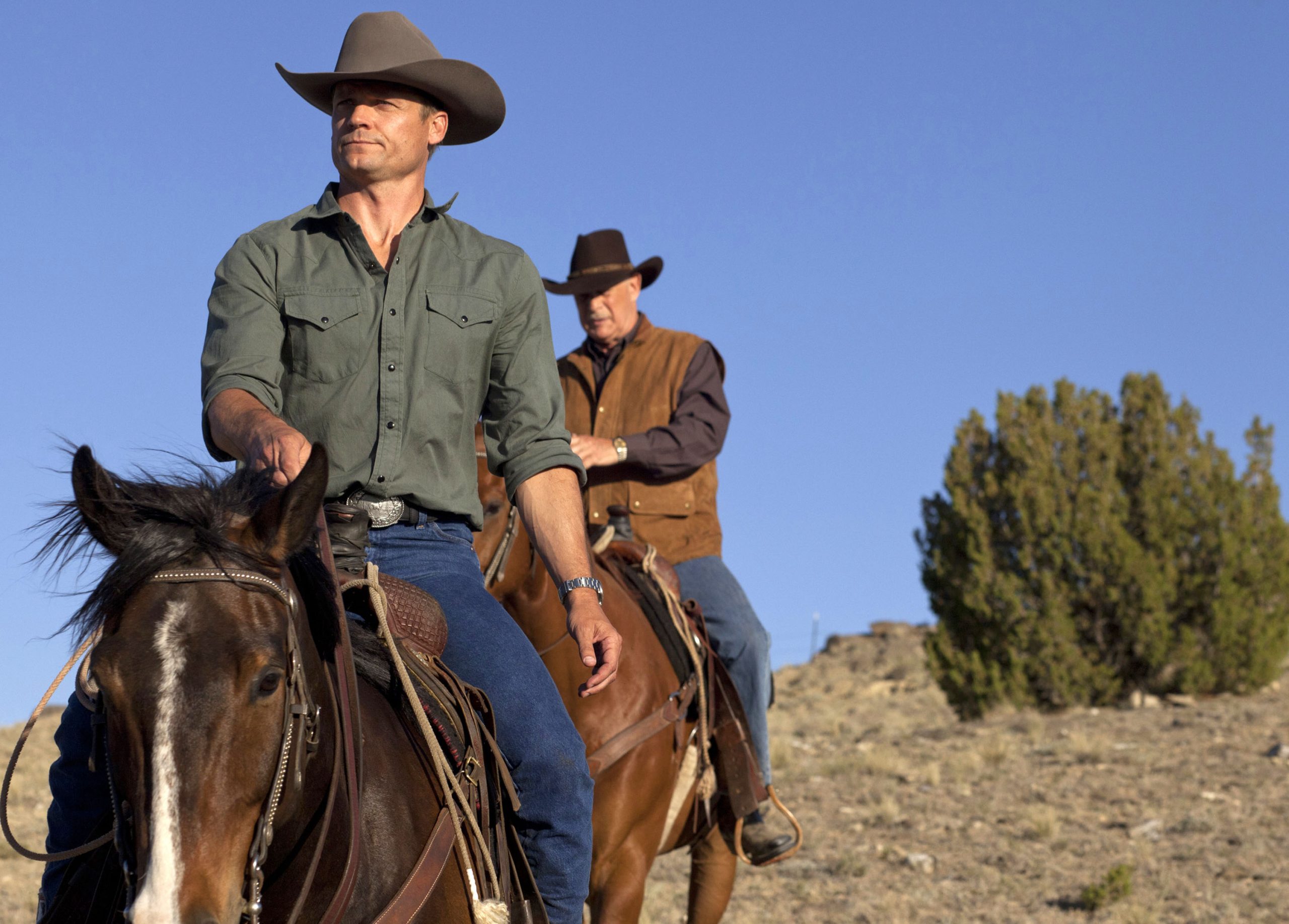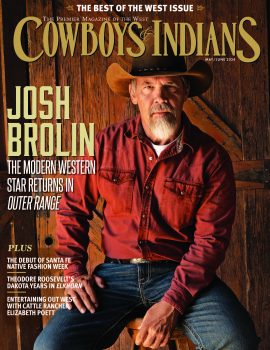Actor Bailey Chase shines on Longmire as Branch Connally, the deputy who chaps his sheriff's hide in more ways than one.
Bailey Chase is on his way to shoot a campaign commercial. But don’t misunderstand: He’s not really a politician. He just plays one – sort of – on television.
Specifically, Chase plays Branch Connally, the ambitious deputy of the title character in Longmire, the popular A&E Network series based on the western-mystery novels by Craig Johnson.
Seasoned sheriff Walt Longmire (Robert Taylor), the hero of the piece, is a taciturn professional who relies on his well-honed instincts – and trusted allies like long-time best friend Henry Standing Bear (Lou Diamond Phillips) and transplanted-from-Philadelphia deputy Victoria “Vic” Moretti (Katee Sackhoff) – while uncovering dark secrets and investigating violent crimes in the fictional Absaroka County of contemporary Wyoming.
Despite his sporadic battles with personal demons, Walt is very good at his job. But maybe not so good that he can’t be defeated in an upcoming election by Deputy Connally.
Throughout much of the series’ highly rated first season, Chase – egged on by his rich and powerful father, Barlow Connally (Gerald McRaney) – tried to balance his ongoing duties as a dedicated law-enforcer with the challenge of campaigning against a veteran incumbent. Along the way, he discovered that, yes, it’s true, politics really can make for strange bedfellows: Chase had an affair with Cady Longmire (Cassidy Freeman), Walt’s lawyer daughter, who did her best to keep her father from learning of her romantic entanglement.
Trouble is, her best wasn’t quite good enough.
By the end of the Season One, Chase and Cady were no longer a couple – but not quite over each other, either. And while Chase previously shied away from using the sort of full-contact campaign tactics recommended by his dad, the season finale episode had him taking a meeting with one of Walt’s enemies, shady attorney and Cheyenne advocate Jacob Nighthorse (A Martinez).
So does that mean, during Season Two, we’ll see some sort of unsavory alliance? “Could be,” Chase says while driving to the Santa Fe location that doubles for Wyoming in Longmire. “But then again, I don’t know. I may start down that road, and then realize that’s not right. You know, Branch does have a very high moral code. And I think that will dictate what direction he ends up going.
“I do know that we’re planning on having the election this season. So we’ll see how that winds up.”
Mind you, Chase isn’t trying to be coy: At the time of our late-spring telephone conversation, he’s only midway through production of the second season’s second episode, and isn’t privy yet to what the scriptwriters have in store for him. Or for Branch Connally.
Besides, Chase knows better than to expect too much advance info because, hey, Longmire isn’t his first rodeo. The 41-year-old, Chicago-born actor had a supporting role as demon hunter Graham Miller in 13 episodes of TV’s Buffy the Vampire Slayer, and later spent three seasons as homicide investigator Butch Ada opposite Holly Hunter’s free-wheeling Oklahoma City police detective in Saving Grace. At this point, he knows full well that, when it comes to future plot twists, actors almost always are the last to know what will happen to their characters.
On the other hand, Chase is willing to concede that, since the show is called Longmire, not Connally, and Walt has remained undefeated as sheriff in the Craig Johnson novels, an electoral upset probably isn’t in the cards. At least, not in Season Two.
“Let me put it this way,” Chase says in a mock-conspiratorial tone. “I haven’t called my bookie in Vegas to put any money down on Branch Connally. Not in the first election, anyway.”
Cowboys & Indians: What do you think are the most important things you discovered about Branch Connally during Season One?
Bailey Chase: Well, the thing to remember is, my character is the only main character who’s not established in the books. And so I had some questions coming in to the series about who this guy was. I just wanted him to be able to be his own man, and not just a one-note bad guy or adversary. Obviously, the writers came through on every front over the course of the first season, and they wrote really well for Branch. And I’m really happy where we’re picking up in Season Two, right where we left off.
Branch and Longmire are still going head to head. But, again, he’s also becoming more and more of his own man. Walt has a few years on him – and some more experience and wisdom. But I feel like Branch is closing the gap.
Let me put it this way. I haven't called my bookie in Vegas to put any money down on Branch Connally. Not in the first election, anyway. — Bailey Chase
C&I: Well, it looks like you were more than holding your own in the fistfight near the end of last season.
Chase: [Laughs.] You know, I feel like I was just starting to get the upper hand. The longer it went, the longer it was going to benefit me. But then that damn Vic showed up.
C&I: And now that you’re into Season Two…
Chase: I’m taking this journey with everybody else in real time. I don’t know what the future’s going to bring. I’ve been told a couple of story points. But other than that – I get every new script, and I’m as excited as I was when I got the last one to see where it all goes.
It’s like, during Season One, I was pleasantly surprised by the evolution of my character, and how human they made him. Obviously, Branch has some issues with his father. Ultimately, as the season progressed, the reason I wound up going head to head with Walt in the season finale is, I felt betrayed. Not just by him, but also by his daughter. And that justified Branch’s actions, in my mind, in terms of going to Jacob Nighthorse’s office. I don’t even know where that’s going yet.
But at that stage in the story, Branch felt like he really had no other option. You see me at the end, driving golf balls out there at night. And when [Cady] comes up, I just tell her, “I’m no quitter.” So the audience knows that Branch is going to stick around. But he may not be the easiest guy to work with in the near future.
C&I: In a way, you have a distinct advantage over the other lead players – you don’t have to worry about living up to the expectations of people who are fans of Craig Johnson’s novels.
Chase: In a lot of ways, yes, that’s true. Because, for example, the writers pretty much have free rein with me. They’re not constrained by anything, you know? This is uncharted territory as far as Branch is concerned, because I’m just a figment of their imagination. And so in a lot of ways I think it’s great for the writers to have that luxury. Whereas with the other main characters, they’re very well-established in the books. They’re all solid, too. But it’s just a different deal for Branch.
And I have to say: The writers have been very complimentary. They’ve come back to me and said, “The more we’re writing this character, the more we see of you gives us a better handle on Branch.” So it’s been a great collaboration here. Which makes me all the more excited about Season Two.
C&I: Many people have referred to Longmire as a modern-day western. Would you agree that’s a spot-on description of the show?
Chase: Absolutely. I think we’ve just found a great niche in terms of being contemporary, yet also being set in this remote part of Wyoming. And I think people still relate to that area in a special way.
It’s like, while I was growing up, watching Clint Eastwood movies – that was what created the fantasy of westerns for me. But today, we’re so strapped to our iPhones and iPads and i-whatevers – it’s change of pace to watch Longmire, and see us roaming around these mountains, sometimes on horseback. Now we’re the ones kind of fulfilling people’s western fantasies.
I can still remember that episode we did during Season One where there was that barn-burning, and the horses got trapped – I still get goosebumps thinking about that one.
C&I: Speaking of horses: Whenever we’ve seen Branch riding on the show, you’ve looked pretty comfortable in the saddle. Did you have much experience on horseback before signing up for Longmire?
Chase: Well, I was born in Chicago, but I started out in a suburb called Barrington Hills. My dad had a horse farm out there. And my brother and I both had ponies while we were growing up. So that was pretty fun. We used to do the little Hunter Jumper shows.
C&I: How did you fare in the competitions? Any trophies?
Chase: [Laughs.] We won ribbons. My brother, being a couple years older than me, got the edge on me. I think he got more blue ones, and I got more red ones. But we both got ribbons nonetheless.
C&I: Were you a fan of Craig Johnson’s novels before you were cast in Longmire?
Chase: Actually, I was not. I wound up reading A Cold Dish after I got the pilot. And now I’m up to Hell is Empty. I have to say – Craig’s an awesome writer. I really enjoy his stuff. And he’s given us a great framework to draw off of.
C&I: Longmire seems to be a very physically demanding show. And not just when Walt and Branch are duking it out. What have been some of the unique challenges you’ve faced while shooting on location in New Mexico?
Chase: There really haven’t been any hardships. I mean, yes, sometimes we shoot it at 8 or 9,000 feet, up in the thin air and the snow. But that just makes it more fun. You might get cold or whatever, but it’s cool when you look back on it and it looks great on TV. You think, “Wow, I did that.” So you have a sense of accomplishment. As opposed to shooting in front of a green screen, and being on a soundstage all the time. That would be a little bit like Groundhog Day. Just boring.
C&I: So what do you and you fellow cast members do in and around Santa Fe during breaks in filming Longmire? Go bowling?
Chase: [Laughs] It’s funny that you ask that. We did go bowling – once – last year. And nobody bowled particularly well. But I golf. I play a lot of golf when the weather warms up. And last week in Taos, I went snowboarding. Other than that? I went fly-fishing last year. And I hike a lot with my dog.
C&I: What do you think you’ve learned from working with your costar, Robert Taylor?
Chase: If I had to pick one thing that I’ve learned from him, it’s to do less. And to be still. He does more than enough, but never too much. I just want to emulate that. As long as you’ve got it going on in the inside, you don’t need to do anything more.
C&I: Any chance Branch and Cady will be able to patch things up and make a go of it together?
Chase: I think we can. I think anything’s possible. I don’t think you’ll see it right away, but if Branch has any kind of Achilles heel, it’s his feelings for her. And I think the audience has appreciated seeing that. I know our writers liked it. The truth is, I really don’t know what will happen. [Laughs.] But I’ll tell you this: I think I have a better chance of that happening than winning the election.
Notes from the Edge
Longmire’s production designer shares the tricks of the trade.
I feel myself sink deeper and deeper until I am up to my waist in the snow. This day couldn’t get any worse. That is until my iPhone chimes in — it’s my decorator sending photos of drapery swatches. These are drapes for a location I know we just lost 20 minutes ago when our schedule changed. I am standing on the side of a mountain 10,000 feet above sea level, huffing and puffing as I climb the slope trying to find the perfect place to create a mine shaft, and now I have to pick out drapery. Such is the life of the production designer of Longmire.
I try to explain to my dad what a production designer is — he doesn’t get it. Maybe it’s because I am not always sure myself how we do what we do. Each week, my talented group of artisans and I turn Santa Fe, New Mexico, into Absaroka, Wyoming, creating the world for the story to evolve in.
I am the guy in charge of creating the “look” of a show. I design the sets, help pick the locations, and work with the director to turn the words on the page into reality, or at least our version of reality. Right now, I am wishing that the writers didn’t write a blizzard into our little version of reality.
As the designer of successful shows like Longmire and Justified, I am the go-to guy for the modern-day cowboy look. I have become a connoisseur of hollers, log cabins, and the proper integration of antlers into most any décor. Designing the look of the scenery for these amazing shows really has its basis in transformation. Every day is like an episode of Extreme Home Makeover, as we either build the sets from scratch or modify existing locations to fit our needs.
Sometimes it’s simple tweaks, like changing out all the Southwestern décor in a diner and replacing it with northern Wyoming appropriate details, adding some vintage Formica and classic deco stools to give it the proper sense of place.
Most of the time, if I do my job properly, you will never notice. You will watch the show and assume we went into some existing place and just plopped our cameras down and shot the scene. If we’ve done a really good job, every postcard on the fridge, every soot stain above a potbelly stove, and every pile of dirty clothes will seem as real as the snow I am sinking deeper into.
After climbing down off the mountain, my crew and I head two hours back into town to look at the new location for the hunting lodge. I have a very clear vision of what I want, but the logistics of TV work very seldom allow for perfection. Our hunting cabin has to be within a few miles of the interior set of the gold mine (which is an old turquoise mine) and finding a hunting lodge in this area is not as easy as one might think.
Walking in the front door of the rustic home once owned by some famous actress, I am taken aback by it’s sturdy feel, massive log beams, and, unfortunately, by the bright airiness of it all. It would be great if you lived there, but it’s a terrible setting for the site of a late-night murder.
We set to work turning it into a primitive hunting cabin. We add a paneled wall to block off the sun porch, creating a more enclosed space. Then we outfit it with a variety of hunting trophies to let the audience know the character’s style and hobby. Bright fabrics and houseplants are replaced with rich leather and wood tones to complete the transformation. All this is done in a matter of days, and then we restore it to its previous state, without any blemishes to say we were there.
My phone rings again. I pause to wonder how we ever did business before cell phones and e-mail, and wish for a moment that we could go back to doing it that way. There are issues back at the sound stage and I have to head over to debate how “rotted” is rotted when it comes to old floorboards.
In the new episode, our main character, Walt, is on an epic trek up a mountain chasing down a bad guy. On his way, he has hallucinations about his life that challenge him to keep moving. In one, he walks up to an old abandoned cabin only to find the interior warm and inviting, with his daughter there to comfort him. He passes out and awakes in the same structure, only now it is devoid of warmth and filled with despair.
My despair comes when I find out that due to scheduling we only have an hour between filming to change our cozy cabin into its abandoned twin. To prepare for the switch, we start by laying down plank flooring that has been broken and distressed to look just the right level of rotten. This will be the floor for the abandoned cabin, which we then cover with plywood with just the right patina on it to highlight the inviting cabin. The plywood has just enough detail so that when Walt passes out and face-plants, it will look realistic even in an extreme close-up. The warm drapery fabric that I had seen on the mountain works great to bring a dash of color while not overwhelming the scene. Warm light from several kerosene lamps illuminates an earth-tone quilt and loop rug that blend with the variety of wood tones.
I remind myself that whatever I create, it’s the actors and their faces that truly tell the story. Many of my most amazing sets have been hidden behind the close-up of a beautiful face, and I am good with that.
Ready to implement the transformation from new to old, we hang in the wings waiting for the final “Cut.” As the rest of the crew heads off to lunch, we have only an hour to work our magic. The furniture is moved out and the carpenters pull up the plywood floor, revealing the old planks. Down come the drapes to be replaced with moldy, torn burlap, and I copy some ancient corroded window screens that I had seen on a real 150-year-old cabin. An old dilapidated pot-bellied stove replaces the more modern Franklin stove, and a crumbling pile of springs replaces the warmth of the bed. As the footsteps of the crew start echoing onto the stage, we spread twigs, leaves, and rusted cans on the floor to give it the proper level of desolation. It’s now ready for Walt to live out his hallucination in.
I don’t always get it right. The occasional viga or coyote fence will sneak into a shot here or there, or there might be a misspelling in one of our 200 signs at the Basque festival. But when we get it right, and we are able to transport the audience into the fictitious world of Absaroka County, Wyoming, and make it believable — it’s the best job in the world.
— Dave Blass
From our August/September 2013 issue.



